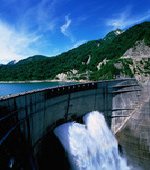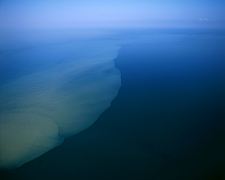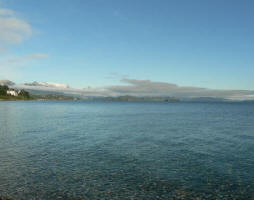Although water problems have been traditionally perceived, understood, and acted on locally, recent progress in Earth-system simulation, remote sensing, and analysis of water governance is producing new perspectives on fresh water. The advances reveal previously unrecognized global forces at work driving local-scale problems. The stage is reset for water research and policy-making.
LOCAL ACTION, GLOBAL CONCERN. Although water problems come best into focus locally, countless local stressors and impacts have accumulated to global significance (1). Local misuse provokes regional water crises that could easily spill into the global domain should transboundary cooperation collapse for rivers (2) or should source waters fail in the Himalayan “Third Pole,” which would affect one billion people (3). Local water management even transcends fresh water itself, as when a large reservoir traps river-borne sediment destined for the ocean and reduces the capacity of the shoreline to withstand coastal erosion (4).
Fresh water is essential to human development. It is no surprise then that Amazonia, the Congo, and Borneo are targeted for massive water engineering projects (5), yet protecting biodiversity in these ecosystems generates little conservation investment, even if its loss would have global effects (6). Despite the importance of water to community prosperity, social fabric, and environment, the World Economic Forum declared proliferation of water crises to be the greatest collective risk to the global economy (7).
GLOBAL ACTION, LOCAL CONCERN. The sources of local water problems may not be as local as they seem. They are influenced by global mechanisms, primarily climate (water availability) and the world economy (patterns of water use). These define the spatial and temporal character of water scarcity. These patterns show current usage already reaching maximum renewable global supplies (8, 9).
Much of the world's water use and pollution arises from production for global trade, which embodies impressive flows of virtual water. Such trade exacerbates local overexploitation and creates potential conflicts over water. It outsources environmental problems to countries with lax regulation that host highly polluting manufacturing or agriculture (8). Decisions on water infrastructure are made far from its ultimate point of installation or impact, and externalities largely remain unregulated.
GLOBAL GOVERNANCE FOR LOCAL STEWARDSHIP? Persistent water syndromes show local water governance unable to prevent global damage (1). At the same time, many global actors (United Nations, banks, multinationals) and rules are already in play, like the UN Watercourses and Ramsar conventions.
Yet, global water governance has not found its place among other scales of authority. Existing regimes are legally fragmented and dominated by local and mesoscale solutions (10). Large-scale governance focuses mainly on transboundary surface waters (versus groundwater), pays scant attention to pollution, fails to reconcile mismatches between river basins (and aquifers) and administrative jurisdictions, and has few incentives for sustainable water use in a globalized economy. It is difficult to harmonize ownership, rights and access to water, and cultural norms across the international playing field. Absent a global perspective, nexus issues on food, energy, and climate will be hard to address because linkages will remain essentially invisible, as with virtual water trade, which is regulated by trade agreements for commodities and not water.
With clear guidelines and legal responsibilities, consumers, governments, and investors could reverse the proliferation of free riding, commodification of public goods, secret international contracts and arbitration, and environmental neglect. Without such, widespread damage and nonsustainable water use will remain the norm.
A GLOBAL TEST CASE. An example of comprehensive water planning is unfolding in the intergovernmental arena with the post-2015 Sustainable Development Goals (SDGs) (11), which build on the earlier Millennium Development Goals (MDGs). Although MDG outcomes have been mixed [the drinking water target for the poor attained ahead of schedule, but delayed for sanitation (12)], they served as an important motivator for member states to prioritize water development efforts. SDGs expand the MDG agenda to include developing and developed world alike. Current SDG water proposals seek ecosystem protection, limits to pollution, and early responses to water-related hazards.
SDGs should lead to converging national policies, but much of the planning still focuses on local-scale solutions that fail to recognize broader-scale realities, like the connectivity of water systems. Thus, whereas sewering a developing world city improves the lot of urban dwellers, failure to install wastewater treatment destroys aquatic biodiversity and elevates health risks and water treatment costs downstream. Because 80% of today's sewage is discharged untreated (11), the issue is far from theoretical. Water systems will require substantial rehabilitation, nearly always much more costly than problem prevention, and will miss opportunities to apply new ecosystem-based approaches (1).
Despite their importance, the water-related SDGs alone will not effect a transition to global governance. International trade agreements need to be supplemented with context-specific but universally agreed-upon rules and standards on sustainable water use, water quality, and environmental flows. Principles like polluter/user pays and equitable water sharing are key to avoiding perverse incentives that have historically externalized impacts.
The global perspective is essential—but not a panacea. It may be counterproductive should it obscure, devalue, or fail to reflect the unique character of local or national settings. Experience shows that implementation of global measures is contingent upon political will, robust design, and institutional capacity at subsidiary scales (7).
In conclusion, acknowledging that local actions on water continue to trigger global-scale syndromes is a necessary first step toward effective governance. A global perspective is essential for providing context to local conditions, recognizing commonalities in both problems and solutions, identifying where prevention or remediation is needed most, and tracking progress or backsliding. Global thinking will help craft international agreements on water stewardship that ensure social equity and sustainability. Persistent focus on the local scale will miss such opportunities, which could otherwise make meaningful progress in solving 21st-century water problems that are, in fact, global.
 you are not logged in
you are not logged in





 Fresh water goes global
Fresh water goes global
